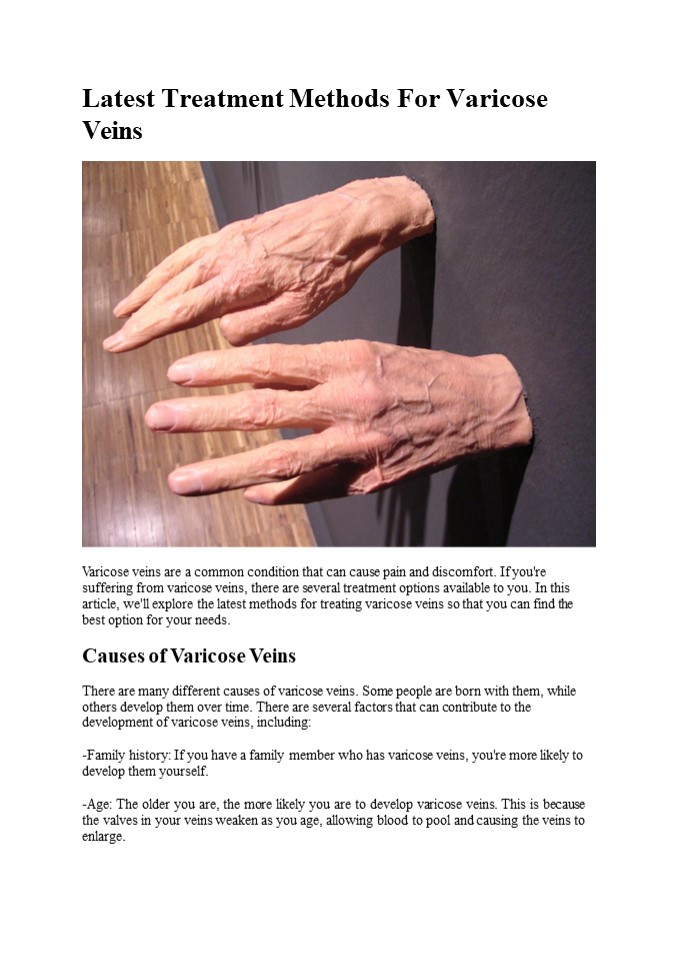Varicose veins latest Treatment - PowerPoint PPT Presentation
Title:
Varicose veins latest Treatment
Description:
Varicose veins are veins that are big, convoluted, bloated, and elevated above the skin's surface. They can happen anywhere, but they tend to happen more often on the legs since standing and walking upright puts more strain on the lower body's veins. – PowerPoint PPT presentation
Number of Views:1
Title: Varicose veins latest Treatment
1
Latest Treatment Methods For Varicose Veins
- Varicose veins are a common condition that can
cause pain and discomfort. If you're suffering
from varicose veins, there are several treatment
options available to you. In this article, we'll
explore the latest methods for treating varicose
veins so that you can find the best option for
your needs. - Causes of Varicose Veins
- There are many different causes of varicose
veins. Some people are born with them, while
others develop them over time. There are several
factors that can contribute to the development
of varicose veins, including - Family history If you have a family member who
has varicose veins, you're more likely to
develop them yourself. - Age The older you are, the more likely you are
to develop varicose veins. This is because the
valves in your veins weaken as you age, allowing
blood to pool and causing the veins to enlarge.
2
- Obesity Carrying extra weight puts additional
pressure on your veins and can cause them to
become damaged and enlarged. - Pregnancy The increased blood volume and
pressure on your pelvic region during pregnancy
can cause varicose veins. - If you have any of these risk factors, it's
important to be aware of the signs and symptoms
of varicose veins so you can seek treatment if
necessary. - Symptoms of Varicose Veins
- If you have varicose veins, you may have noticed
a change in the appearance of your legs. The
veins may be larger and more twisted than before,
and they may be darker in color. You may also
have pain or cramping in your legs, especially
when you stand for long periods of time. In some
cases, varicose veins can lead to more serious
problems such as skin ulcers or blood clots. If
you have any of these symptoms, it's important to
see a doctor so that you can get the treatment
you need. - Newer Treatment Methods for Varicose Veins
- There are a number of new, minimally-invasive
treatment methods now available to treat
varicose veins. These newer methods are much less
painful and have a shorter recovery time than
traditional surgery. - One minimally-invasive treatment option is
endovenous laser therapy (EVLT). This treatment
involves inserting a small laser fiber into the
vein. The laser is then used to heat and seal
the vein shut. EVLT is usually done in an
outpatient setting and does not require
anesthesia. - Another minimally-invasive treatment option is
sclerotherapy. In this procedure, a solution is
injected into the vein which irritates the walls
of the vein and causes them to stick together.
This ultimately seals the vein shut.
Sclerotherapy can also be done in an outpatient
setting and does not require anesthesia. - These newer, minimally-invasive treatments
options offer patients a much less invasive and
more comfortable alternative to traditional
surgery for treating varicose veins. - Which Treatment Method is Right For Me?
3
Laser therapy is another popular treatment
option. This involves using a high-powered laser
to destroy the vein. This method is most
effective for small veins. Radiofrequency
ablation is a newer treatment that uses heat to
destroy the vein. This method is less invasive
than surgery and can be effective for both small
and large veins. Surgery is usually reserved for
more severe cases of varicose veins. There are
several different types of surgery that can be
used, depending on the size and location of the
veins. Your doctor will discuss all of your
options with you and help you choose the best one
for your individual case. Best Treatment Method
for varicose Veins There are many different ways
to treat varicose veins, but which one is the
best? In this blog post, we will explore the
latest treatment methods for varicose veins and
find out which one is the most effective. One
of the newest and most popular treatments for
varicose veins is sclerotherapy. Sclerotherapy
involves injecting a solution into the vein that
causes it to collapse. This method is effective
for both small and large varicose veins. Another
popular treatment method is endovenous laser
therapy (EVLT). EVLT uses laser energy to heat
up and destroy the vein. This method is less
invasive than sclerotherapy and has a shorter
recovery time. Radiofrequency ablation (RFA) is
another newer treatment method that uses radio
waves to heat up and destroy the vein. Like
EVLT, RFA is less invasive than sclerotherapy and
has a shorter recovery time. So, which of these
latest treatment methods is the best? All three
of these methods are effective at treating
varicose veins. However, each person will respond
differently to each treatment method. Therefore,
it is important to discuss all of your options
with your doctor to find out which one
is Conclusion The latest treatment methods for
varicose veins are minimally invasive and can be
done in the comfort of your own home. There is
no need to suffer from the pain and discomfort of
varicose veins any longer. With these new
treatments, you can get rid of your varicose
veins quickly and easily. So if you are
suffering from varicose veins, don't wait any
longer, talk to your doctor about these new
treatment options today.































